Headlines and events archive
Displaying 1001 - 1050 of 1944
You may also find an archive of news published in the media which are related with the Instituto de Astrofísica de Andalucía - CSIC.
Pages
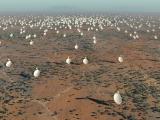
|
04/11/2013
Ten research centres and eleven Spanish companies will take part in the design of SKA, the biggest radio telescope in the world Spanish researchers and engineers will participate in the design of antennas, data transmission, and telescope management and monitoring software |

|
31/10/2013 - 13:30
Digital Science: towards the executable paper The science performed in Astronomy is digital science. This fact does not prevent the final outcome of an experiment is still difficult to reproduce. J. E. Ruiz |

|
30/10/2013 - 10:30
Characterisation of an Isolated Galaxy Sample: Astrophysical Implications In order to understand the evolution of galaxies, it is necessary to have a reference sample where the effects of the environment are minimised and quantified. Recent advances in large redshift galaxy surveys, such as the Sloan Digital Sky Survey (SDSS), allow to reach a 3-dimensional picture of the environment. In the first two parts of this talk, I will present a revision of the isolation degree and a study of the 3-dimensional... Mamen Argudo Fernández Sala de Juntas del Nuevo Edificio (IAA-CSIC) |

|
24/10/2013 - 14:30
AGN feedback and accretion in Perseus A The Perseus Cluster is known as a famous observational example of (radio-mode) AGN feedback driven by the radio jet of the central galaxy Perseus A (NGC 1275, 3C 84). The feedback process is evident from observations of the intra-cluster medium showing X-ray bubbles filled with radio plasma. The radio jet generating these bubbles is powered by accretion onto the supermassive black hole in Perseus A. In this talk, I will present our results... Dr. Julia Scharwächter |
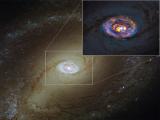
|
24/10/2013
Does the diet of a supermassive black hole affect the host galaxy? Using the ALMA telescope, it has been possible to observe NGC 1433 in detail, which presents a complex system of rings, bars and spirals that guide gas toward the central supermassive black hole |

|
17/10/2013 - 14:30
The Martian ionosphere The ionospheres of the planets (those regions with a significant fraction of free electrons and ions) provide interesting clues about the interaction of the solar radiation and the solar energetic particles with the planetary atmospheres.They can also be used to gain information about the density and temperature of the neutral upper atmospheres, a region that in the Martian case has traditionally eluded observation. In this talk I will sketch... Dr. Francisco González Galindo |
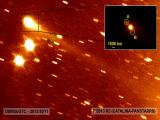
|
17/10/2013
Fragmentation of main-belt comet observed for the first time P/2013 R3 (CATALINA/PANSTARRS) is classified as a "main-belt comet”, an unusual type of asteroid that exhibits similar traits to those of comets |

|
10/10/2013 - 14:30
Hot potatoes: the compact obscured nuclei of dusty IR galaxies Evidence is now mounting that most of the activity in some luminous infrared galaxies takes place in their compact obscured nuclei (CONs), regions of less than 100~pc in diameter, which harbor large amounts of warm (T$>$100~K) molecular material (N(H$_2$)$>10^{24}$~cm$^{-2}$). The combined effect of warm, shielded gas and intense infrared radiation produce rich molecular spectra, which make these objects unique laboratories to study... Dr. Francesco Costagliola |
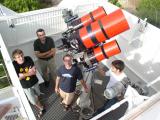
|
09/10/2013
Telescopes that do everything Robotic telescopes study everything -from objects in our Solar System and galactic nuclei to transitory phenomena such as explosions of gamma rays- without human intervention |

|
07/10/2013 - 11/10/2013
Third Workshop on Robotic Autonomous Observatories Málaga |

|
03/10/2013 - 14:30
Spectroscopy of the short GRB 130603B: The host galaxy and environment of a compact object merger The nature of short duration gamma-ray bursts (GRBs) remains a central problem of modern astrophysics. They are thought to be related to the violent merger of compact objects, such as neutron stars or black holes, which would make them promising sources of gravitational waves. The absence of supernovae signatures clearly indicates that SGRB progenitors differ from their long duration cousins, but constraints to-date arise almost entirely from... Dr. Antonio de Ugarte Postigo |

|
26/09/2013 - 14:30
Main-Belt Comets Since the discovery of 133P/Elst-Pizarro in 1996, an object moving in a typical Main Asteroid Belt orbit, but displaying a comet-like tail, nine more of those objects have been identified. They constitute a new class of small Solar System bodies, the ``missing link'' between asteroids and comets. Three of those objects fall into the ``disrupted asteroids'' subgroup, where the activity is suspected to be driven by either a... Dr. Fernando Moreno |
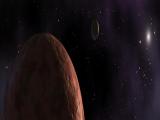
|
26/09/2013
The Researcher´s Night at the IAA The Resercher's Night at the IAA: an opportunity to know the cosmos guided by scientists |

|
23/09/2013 - 27/09/2013
Galaxies meet GRBs at Cabo de Gata Granada |

|
12/09/2013 - 14:30
Cosmological Simulations of Galaxy Formation We present a suite of simulated galaxies, that match a wide range of scaling relations over a large mass range at z=0, and follow the evolution of these relations and confront them with observational constraints. We then make connections to "galactic archaeology" by examining the nature of the major structural components of the discs, highlighting that far and near field cosmology can be combined using these types of simulations. We... Dr. Chris Brook |

|
05/09/2013 - 14:30
SN 1993J and M81: a fruitful astrophysical collaboration SN1993J, a powerful radio supernova high in the northern sky, has been monitored with VLBI though its lifetime. The VLBI observations have been phase-referenced to the core of M81. We will highlight the main results obtained: its extremely circular shell-like radio structure has expanded over 15 years in a rather self-similar way; the expansion is wavelength dependent, a result which can be mainly explained by a combination of a varying free-... Prof. A. Alberdi |

|
18/07/2013 - 14:30
Can we solve by solar magneto-seismology one of astrophysics great problems: Coronal heating enigma? The latest satellite and ground-based observations have provided us a wealth of evidence of waves and oscillations present in the solar atmosphere from the low photosphere to the upper corona. Our understanding of the magnetically dominated structures and their dynamics in the solar atmosphere has been considerably enhanced in light of the latest high spatial and temporal resolution observations (e.g. DST/ROSA, IBIS, CoMP, SST/CRISP; SOHO,... Prof. Robertus von Fay-Siebenberg |

|
15/07/2013
Granada hosts a high level international scientific summit on low-temperature plasma The International Conference on Phenomena in Ionized Gases (ICPIG) is bringing together over five hundred researchers in Granada this week |

|
14/07/2013 - 19/07/2013
ICPIG - 2013: International Conference on Phenomena in Ionized Gases Granada |
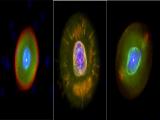
|
12/07/2013
Is the central star of the Eskimo Nebula a binary system? A study has revealed anomalies in the Eskimo Nebula that suggest that its central star could be double This study provides robust evidence on the existence of a conduction layer which transfers thermal energy produced in the collision of stellar winds in planetary nebulae |

|
04/07/2013 - 14:30
The ALHAMBRA survey: First Data Release. The ALHAMBRA (Advance Large Homogeneous Area Medium Band Redshift Astronomical; Moles et al. 2008) survey has observed 8 different regions of the sky, including sections of the COSMOS, DEEP2, ELAIS, GOODS-N, SDSS and Groth fields using a new photometric system with 20 contiguous, ~300A width, filters covering the optical range, plus deep JHKs imaging. The observations, carried out with the Calar Alto 3.5m telescope using the wide field... Alberto Molino |
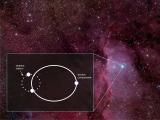
|
04/07/2013
Direct detection of the tertiary component in the stellar system HD 150136: a step forward in the study of extreme-mass stars Massive stars have, despite their scarcity, a huge influence on the structure and chemical evolution of galaxies |

|
27/06/2013 - 14:30
CALIFA tbd Dr. Sebastián Sánchez |
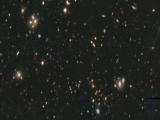
|
24/06/2013
First data release of the ALHAMBRA sample, the final catalog for the study of the cosmic evolution ALHAMBRA studies in detail eight deep regions of the sky, which make it the best available tool to know the recent history of the universe |

|
20/06/2013 - 14:30
El Universo de Planck Recientemente se han presentado los resultados cosmológicos de la misión espacial Planck. Es un buen momento para poner al día el valor de los parámetros del Universo. La nueva composición se resume en 26.8% materia oscura, 4.9% materia visible, 68.3% energía oscura. El valor de la constante de Hubble ha resultado también muy inferior a lo esperado: 67.5 km/(s Mpc). La conclusión m... Prof. E. Battaner |

|
13/06/2013 - 14:30
Love for Science or 'Academic Prostitution'? Note: This is a seminar given at the European Research Council Headquarter some weeks ago. It was focused on the expected audience, members of the ERC directly involved in setting the rules for Grants evaluation and/or participate in all steps of the process, mainly Scientific Officers, but also Agency staff. I have decided to present the talk as it was presented there. Abstract: In a recent Special issue of Nature concerning Science... Dr. Lourdes Verdes-Montenegro |
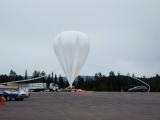
|
12/06/2013
SUNRISE, the balloon-borne solar telescope, flyes over the Arctic again SUNRISE, a balloon-borne solar telescope to study the sun's magnetic field, has been launched today from the Esrange Space Center, near the town of Kiruna (Sweden) |

|
10/06/2013 - 14/06/2013
Jets 2013: The Innermost Regions of Relativistic Jets and Their Magnetic Fields Granada |
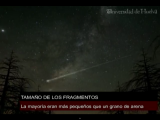
|
07/06/2013
Draconids 2011: a ton of fragments from a comet struck the earth at 83,000 miles per hour In October 2011, the Earth crossed the trail of gas and dust from the comet 21P/Giacobini-Zinner, triggering the intense rain of shooting stars known as Draconids |

|
06/06/2013 - 14:30
PAH's in Titan's Upper Atmosphere Observations of Titan's atmosphere made with the VIMS instrument on board the Cassini satellite show a strong limb emission around 3.3 µm at high atmospheric altitudes (above 700 km). This emission exhibits the typical spectral signatures of the strong CH4 bands. A detailed analysis of the spectra reveals, however, an additional strong emission centered at 3.28 µm and peaking at about 950 km. We have untangled this spectral... Prof. Manuel López-Puertas |
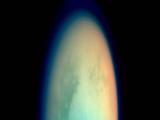
|
05/06/2013
Identified the molecules that form Titan´s haze, responsible for the stability of the atmosphere Astronomers from the IAA have analyzed an emission detected few months ago in Titan's atmosphere and reveal the existence of large amounts of polycyclic aromatic hydrocarbons. These compounds, generated in the upper atmosphere, descend to lower levels and form the haze that covers the satellite, heats the atmosphere and prevents condensation |
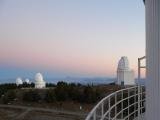
|
05/06/2013
Disagreement of the staff of the Institute of Astrophysics of Andalusia with the drastic cut to the Calar Alto Observatory (CAHA) The staff of the Institute of Astrophysics of Andalusia (IAA-CSIC) disagrees with the recent addendum to the agreement between CSIC and MPG which reduces the budget, stops funding two of the telescopes and involves the dismissal of staff |

|
26/05/2013 - 15:00
Estudio multi-frecuencia de las historias de formación estelar espacialmente resueltas de galaxias en el cartografiado de campo integral CALIFA. ¿Por que estudiar las poblaciones estelares? Los diferentes procesos evolutivos dejan un registro fósil diferente en las propiedades de población estelar de las galaxias. Un metodo muy potente que permite estudiar la formación y evolución de las galaxias consiste en reconstruir la historia de formación estelar a través de las propiedades de las estrellas que las forman. Actualmente se utiliza la técnica de síntesis evolutiva para inferir las... Rafael López Fernández Otra |

|
23/05/2013 - 14:30
Extreme emission-line galaxies: New light on the mass assembly and chemical enrichment of low-mass galaxies Galaxies showing early and significant stages of mass assembling are key objects for understanding galaxy evolution. However, young starbursts like these are extremely rare in the local Universe. In this context, a unique population of compact, low-mass galaxies forming stars at unusually high rates - also known as the "green peas" - emerge now as ideal laboratories to study the details of massive star formation, feedback and... Dr. R. Amorin |

|
16/05/2013 - 14:30
Hall motions and star escape in galactic dynamics in the Hill approach The motion of a galactic cluster is approximately described by those equations in a co-moving frame, introduced by Hill in the XIXth century. Individual motions can only studied numerically, but for the center of mass interstellar gravitational forces drop out and one is left with a simply system analogous to those considered by Hall for a planar electron in crossed electric and magnetic fields. In both cases, the motion of the COM is... Dr. P. Horvathy |

|
09/05/2013 - 14:30
The IAA COsmic DUst LABoratory, a lab next door (building). MAIN GOALS of this talk: 1. Let you know/remind you that the IAA has a worldwide reference light scattering laboratory for experimentally studying the angular dependence of the scattering matrices of dust samples of astrophysical interest. 2. Convince the audience of: - Polarization is highly valuable tool for retrieving information on the physical properties of small cosmic dust particles. - How useful laboratory measurements... Dr. O. Muñoz |

|
25/04/2013 - 14:30
X-raying born-again planetary nebulae Planetary nebulae have been a addition to the zoo of X-ray-emitting sources. Here I present results on a the very particular class of born-again planetary nebulae, those whose central star has experienced a helium shell flash during the lifetime of the planetary nebula. The interaction of the fast stellar wind of the central star with hydrogen-poor material ejected during the born-again episode provides a unique case to study... Dr. M. Guerrero |

|
22/04/2013 - 26/04/2013
HOPS Spring Meeting Granada |

|
18/04/2013 - 14:30
The Shortest-Known–Period Star Orbiting Our Galaxy’s Supermassive Black Hole Stars with short orbital periods at the centre of our Galaxy offer a powerful and unique probe of the nearest supermassive black hole. Observing these stars is a long-term astrophysical experiment that has been going on for two decades. In this talk I will outline this project and discuss the observational challenges and the strategies to overcome them. Steady technological and methodological advances allow us to improve... Dr. Rainer Schoedel |

|
17/04/2013 - 15:00
A strong recollimation shock far from the core of the radiogalaxy 3C120 Which could be the mechanism for the production of moving and stationary components in AGN jets? How is it possible that a stationary component appears to be composed by subcomponents moving at superluminal speeds? The AGNs are a special class of galaxies that show an unusual amount of emission. The responsible of this emission is a supermassive black hole () that accretes matter from a hot rotating disk, leading to the formation of ultra... Carolina Casadio Otra |

|
11/04/2013 - 14:30
CALIFA: The spatially resolved Star Formation History of Galaxies The Calar Alto Legacy Integral Field Area (CALIFA) is an ongoing 3D spectroscopic survey of 600 nearby galaxies of all kinds. This pioneer survey is providing valuable clues on how galaxies form and evolve. Processed through spectral synthesis techniques, CALIFA datacubes allow us to, for the first time, spatially resolve the star formation history of galaxies spread across the color-magnitude diagram. The richness of this approach is already... Dr. R. González Delgado |

|
04/04/2013 - 14:30
Probing Galaxy-Scale Halos and Large-Scale Structure with Weak Gravitational Lensing The presence of dark matter in the Universe is well-established and contributes significantly to structures ranging from galaxies to superclusters. However, the details of the connection between luminous galaxies and the dark matter halos in which they reside are not particularly well-characterised. Weak gravitational lensing is the only direct probe that can measure the total mass profile associated with galaxies over a wide range of radii... Dr. Ami Choi |

|
04/04/2013
Young "suns" shine in X-rays in the Small Magellanic Cloud Chandra observations of the SMC have resulted in the first detection of X-ray emission from young stars with masses similar to our Sun outside our Milky Way galaxy |

|
21/03/2013 - 13:30
The Javalambre-PAU Astrophysical Survey The Javalambre-PAU Astrophysical Survey (J-PAS) is a very wide field Cosmological Survey to be carried out from the Javalambre Observatory in Spain with a purpose-built, dedicated 2.5m telescope, using a set of 54 narrow band and 5 broad band filters over a 1.3Gpix, 5deg2 FOV camera. Starting in early 2015, J-PAS will image 8500deg2 of Northern Sky and obtain 0.003(1 + z) precision photometric... Dr. N. Benitez |

|
19/03/2013 - 16:00
Martian dust (analogs) in Scattering Laboratory Laboratory in Institute of Astrophysics? Doesn´t it sound a bit strange? What can be measured there? How can it be applied in Astrophysics? During my CCD talk I would like to respond those and another questions. Firstly, I will make a breve introduction into The Scattering Laboratory called as well Cosmic Dust Laboratory ubicated in UDIT. And then I will talk you about the subject I work on- The Scattering on Martian Dust Analogs. Dust... Dominika Dabrowska Otra |
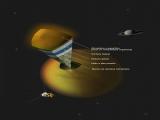
|
18/03/2013
Misterious gas in Titan´s atmosphere Titan, Saturn´s biggest moon, is the only satellite in the Solar System with a dense atmosphere and the only object other than Earth with confirmed surface liquid material. The analysis of the data obtained by Cassini-VIMS instrument reveals the existence of an unidentified gas in the atmosphere |

|
14/03/2013 - 13:30
Towards a general classification of atmospheric waves on Venus The atmospheric superrotation of Venus goes on being a puzzling phenomenon in the Solar system and is still considered an open problem in geophysicalfluid dynamics. A general agreement exists among numerous works concerning the main role that atmospheric waves should have in the generation and maintenance of the superrotation, although most of them try to study the impact of the waves with complex GCMs or using adapted terrestrial dispersion... Dr. Javier Peralta Calvillo |

|
06/03/2013 - 13:30
Hot Intergalactic Gas in Clusters of Galaxies Clusters of galaxies are the most massive objects in our Universe. Each of them contains dark matter, thousands of galaxies and is filled with hot intergalactic gas radiating in X-rays. Unusual method to detect clusters of galaxies is possible due to presence of extremely isotropic Cosmic Microwave Background Radiation (CMB) filling our Universe. Interaction of hot electrons with CMB photons changes the CMB spectrum in the... Prof. Rashid Sunyaev |

|
27/02/2013 - 16:00
¿Por qué estos !!! de GRBs me interrumpen las observaciones? ¿Quién no ha estado tranquilo y feliz en un observatorio y de repente alguien llama por teléfono solicitando una observación urgente de una contrapartida óptica de un GRB? Correcto, a mí me pasó en unas prácticas de la universidad... y no por ello les odié... más bien atrajeron mi curiosidad y... finalmente, a mi. En esta charla daré una pequeña introducción a las características observacionales de los GRBs y sus afterglows, así como de sus... Rubén Sánchez Otra |

|
27/02/2013 - 13:30
Mysteries and Discoveries from the Chandra Planetary Nebulae Suvery (ChanPlaNS) Chandra observations of planetary nebulae (PNe) have ushered in a new wave of discoveries and mysteries in this class of evolved stars. The X-ray emission from PNe comes in two flavors: compact sources in the vicinity of the central star and extended sources that fill the nebular cavities generated during the PN formation process. The latter variety, called hot bubbles, are chemically-enriched with helium shell burning products (C, O, and Ne... Dr. Rodolfo Montez |